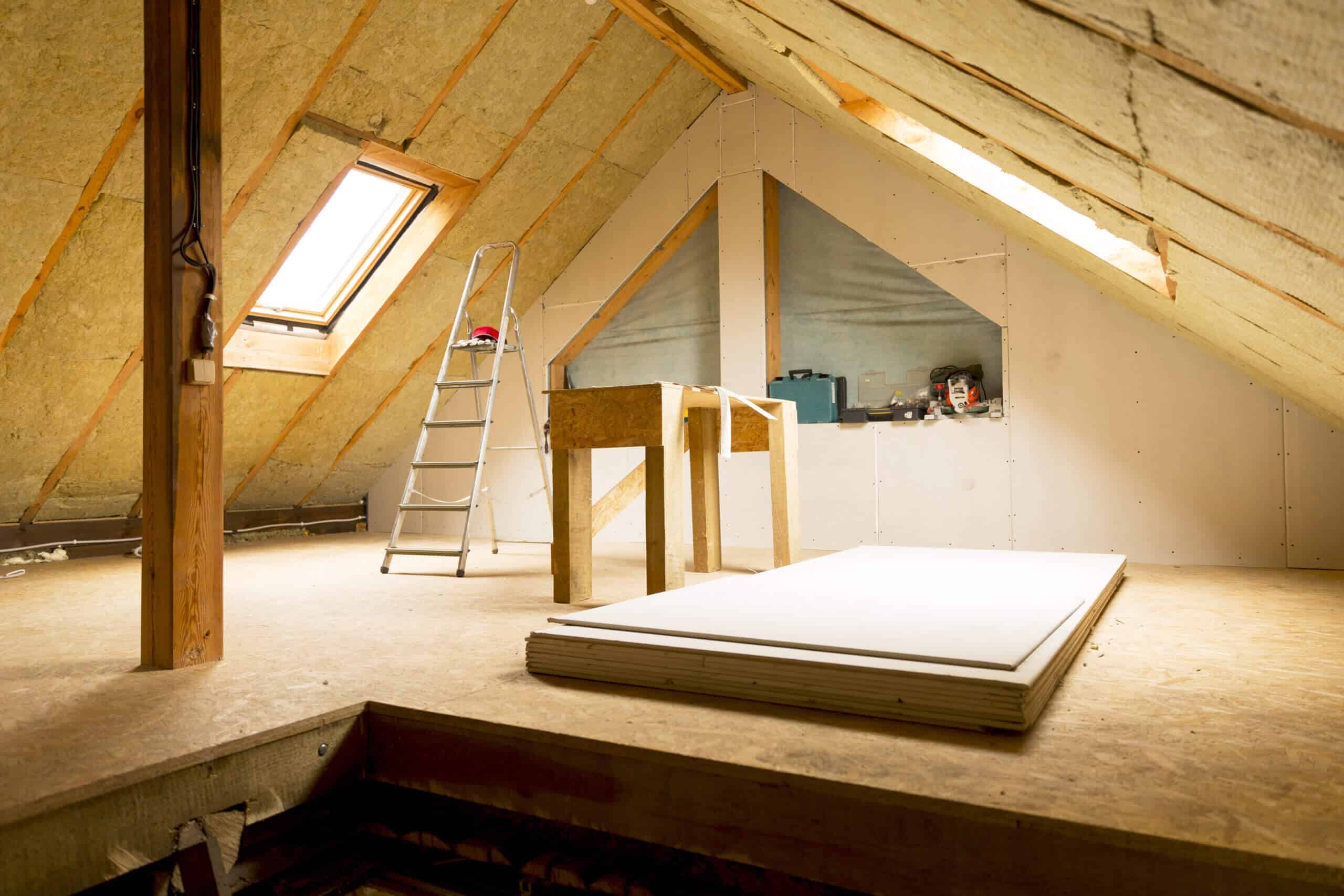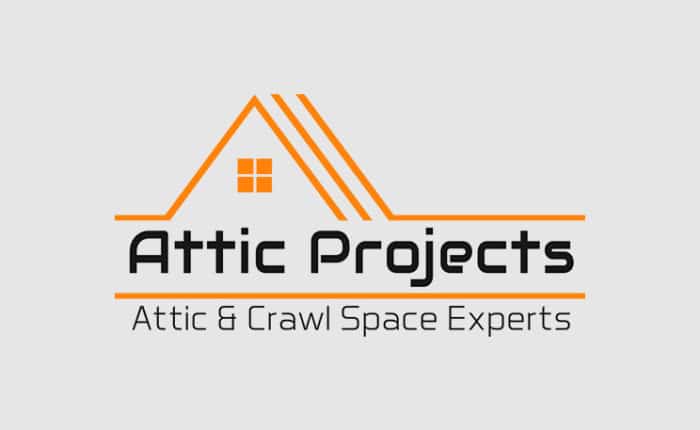Attic insulation helps you save money on energy bills and reduces your home’s carbon footprint. Insulation prevents air from escaping and reduces the amount of outside air entering your home. If you plan on weatherproofing, start by installing attic insulation for energy efficiency.
Attic Projects can help you choose energy-saving insulation materials with professional installation to create a comfortable and safe environment for your home. We have in-house project managers who provide free attic inspections.

Types of Insulation
There is no one-size-fits-all approach to choosing and installing insulation, as every home has different needs. Consider the R-value, durability, cost, and performance of the insulation types. The R-value indicates heat resistance, so the higher the number, the better the insulation.
Fiberglass Insulation
Fiberglass consists of tiny glass fibers with an R-value of 3.1 to 3.5 per inch. Fiberglass insulation is available in two forms: batts and loose fill. Batts come in large, rolled sheets fused by chemical vapor, whereas loose fill can seal gaps when blown into place.
Pros
- Quick Installation: Fiberglass batts come pre-rolled, providing quick and easy installation. Many homeowners choose to install fiberglass batts themselves.
- Moisture Resistance: Fiberglass insulation can withstand moisture and high humidity, thus reducing the chances of mold and mildew growth.
- Fireproof: Fiberglass has fireproof properties, making it safe for wood structures. In the event of a fire, the vapor barrier will slow the spread of the flames.
Cons
- Bad Installation: Improper installation can impact the insulation energy efficiency of fiberglass. Gaps reduce performance by allowing heat to move between the layers.
- Low Performance: Fiberglass has a low R-value compared with other attic insulation types, and its performance decreases when the temperature drops.
Spray Foam Insulation
Spray foam insulation offers the most efficient insulation with an R-value of 3.6 to 6.5 per inch. Spray foam’s energy efficiency insulation comes in closed-cell and open-cell varieties. The insulation can fill every nook and cranny to create the perfect air barrier.
Pros
- Longer Lifespan: Spray foam insulation lasts longer than fiberglass as it does not degrade quickly.
- Home Protection: The polyurethane in spray foam fortifies walls with energy-saving insulation while preventing pests, rodents, and mold from entering your home.
- Energy Efficiency: Spray foam provides an air, vapor, and insulation barrier. Air-tight seals with insulation energy efficiency can improve your home’s heating and cooling system.
Cons
- More Expensive: Spray foam costs more than other insulation types. Additionally, installation requires expensive equipment and experience working with the material.
- Dangerous Gas: Professionals use hydrochlorofluorocarbons (HCFCs) as a blowing agent when applying spray foam. These compounds contain harmful toxins that can affect the ozone layer.
Cellulose Insulation
Nowadays, cellulose insulation has overtaken fiberglass as the industry standard. The material does not pose any dangers and has an R-value of 3.2 to 3.7 per inch. Cellulose energy efficiency insulation also meets all green building certification requirements.
Pros
- Good Fit: Cellulose insulation can settle and conform to any shape and obstruction. Use cellulose insulation for energy efficiency by sealing cracks and crevices.
- Less Expensive: Cellulose costs less than other types of inflation and boasts a good R-value for your money.
- Existing Walls: Cellulose can work with existing structures without removing drywall and injecting loose-fill insulation into finished walls.
Cons
- Open Gaps: As cellulose settles, it can leave gaps or openings, leading to a decrease in R-value and energy efficiency.
- Absorbs Moisture: Cellulose can absorb moisture and take a while to dry. Wet insulation lowers the R-value and encourages mold growth.
How Much Can You Save by Insulating Your Attic?
The Environmental Protection Agency (EPA) estimates that properly insulated attics can save about 15% in annual heating and cooling costs. And yet, 90% of homes don’t have enough insulation. Consider an insulation upgrade if you live in an older home or have inadequate insulation.
Tips for Attic Insulation To Help Reduce Your Energy Bill
Ensure Sufficient Insulation Is Installed
A visual inspection can help you determine whether you need more insulation. You need to add more insulation if you can see your floor joists. Most attics require an insulation level of R-38, which translates to 10 to 14 inches.
Use Air Sealing
Air sealing the attic has many advantages. Air sealing can prevent leaks and keep your home at the right temperature. Combining air sealing with attic insulation prevents ice dams and increases your home’s energy efficiency.
Insulate and Seal the Attic Entryway
Seal your attic entryway using self-sticking weather stripping. Attic doors and hatches allow air leaks and heat loss. To achieve attic insulation energy savings, consider sealing the edges and insulating the back of the door with rigid foam.
Make Sure Vents Are Working Properly
A ventilation system for attic energy efficiency requires balance. Air should enter through the intake vents and exit through the exhaust vents. Check the vents periodically to remove any blockages so trapped air can leave your home.
Install Attic Fans
Attic fans provide cooling for hot spaces. Fans pull cool air from the attic vents and push hot air outside. You will pay more for your utility bills without attic fans because your air conditioner will have to work harder.
Insulate Attic Ductwork
Unconditioned spaces like attics require insulation to prevent leaks. Poorly sealed ductwork can cause your energy bills to rise. Insulate the ductwork to reduce leaks and create an energy-efficient attic.
Add a Reflective Roof
A reflective roof remains 50°F cooler than a non-reflective roof and keeps outdoor heat from compromising a home’s air conditioning. Reflective roofs provide an average savings of 10 to 40% or $3 to $140 per year.
Get Professional Attic Insulation Installation
The experts at Attic Projects will analyze your attic to recommend the appropriate insulation, ventilation, and air sealing. Our team has experience installing attic insulation and polyethylene vapor barriers. We work with energy-efficient insulation and provide exceptional craftsmanship, quality, and care for every removal and upgrade.
Contact Attic Projects today for a Free Inspection to install attic insulation for optimal energy efficiency. Call us at (858) 302-4082.
Recommended Article: Energy Efficient Way to Keep House Cool




